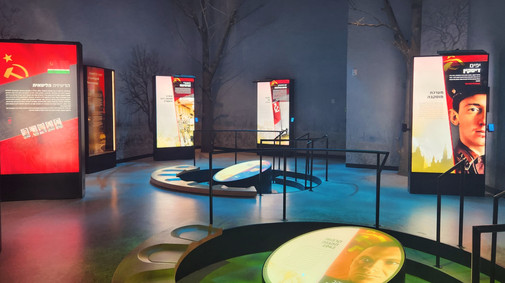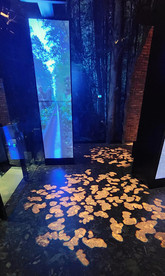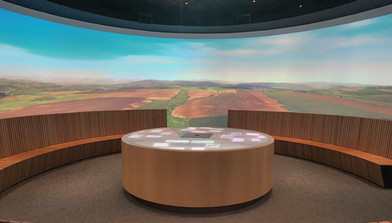Lighting The Chaim Herzog Museum of the Jewish Soldier in World War II
- abrener
- 8 במאי 2024
- זמן קריאה 5 דקות
Promoter:The Association for the Establishment of the Museum of the Jewish Warrior in World War II Lighting Design: Amir Brenner, Ella Cohen Architecture: Zalman Einav, Haim Dotan, Tzvika Tamri, Interior Architect: Einat Klein, Display Design: Studio Nitzan Rafaeli, Project Management: Dan Zigmond, Chairman of the Association: Major General Haim Erez | Brigadier General Tzvika Ken-Tor | Director of Public Relations: Ayelet Kfari Construction, installation and Programming: Danor, Photo: Noa Brenner
The "The Chaim Herzog Museum of the Jewish Soldier in World War II" has been opened to the public after three years of planning and construction. Visitors are exposed to a unique experience that conveys the content in an interactive way - a combination of touch screens, photographs, clothing details, personal letters, authentic period films and staged reconstructions played by actors. All of these are located in spectacular exhibition spaces, each of which has a characteristic color, decor, lighting, music and even a suitable temperature.

The spacious entrance lobby is lit with relatively high illuminance. The colors and light level correspond with the outside of the museum, where gray tanks, and armored vehicles from different periods are displayed in the sand. The lobby is a transition space for acclimatization between the bright light experienced by the visitor before entering the building, and the beginning of the journey inside the exhibition.
At the first stop, one of the walls shows the range of years and countries the museum focuses on. The numbers representing the relevant years are illuminated with internal lighting, and the lower line, which is also illuminated, forms an information wall that accompanies the guides' explanation of the visit. The museum follows the story of over one and a half million Jewish soldiers who fought in the armies of many countries in World War II in the joint effort to defeat Hitler and his army. The untold story of the heroism of the Jewish soldiers in World War II adds an important layer to the Holocaust period in which millions of people perished.

The Time- Elevator is a rectangular space, in which there are stools for a group of visitors to sit and settle down. The general light dims, and a film begins, projected onto all the walls of the room. The film simulates a descent into the depths of the earth, on a journey to another time. The lighting fixtures that have been incrusted in the lower part of the wall continue to shine while the film is projected in order to continue the illusion of space travel.

At the end of the film, a door opens on the far side of the room and the visitor, whose eyes have become accustomed to a low level of light, begins the walking tour through the museum. The next room is a huge model of a globe, above which hover clouds resembling smoke or storms. The model is illuminated in colors which change in a loop, with the help of smart lighting fixtures, programmed as a light show, which create the image of the war clouds over Europe.
The next passage leads to a room where every wall is a projection screen on which one can find information about the countries and military units that took part in the battles. The lighting strip embedded in the ceiling provides a low level of light so that it doesn’t interfere with the projection of information on the walls. All the screens are touch screens. The visitor is invited to tap on a topic of interest and immediately receives more details and expanded information.
Upon entering the hall dedicated to the Jewish soldiers in the Russian army, visitors are enveloped by a chill. A particularly powerful air conditioning system lowers the temperatures significantly which in addition to the blue-gray color of the light creates a winter atmosphere. The floor of the room is lit in blue and green and completes the experience. As the guide's explanation begins, the light in the room dims, and the atmosphere becomes even more wintry and gray.
The next room is dedicated to the Jewish soldiers of the United States Army. The colors in the room - as well as the lighting - correspond with the colors of the American flag - red, white and blue. The models of warships and the plane hanging from the ceiling add depth, and the Moving Lights illuminating the walls and floor in narrow beams, simulate searchlights of a control tower or enemy aircraft lights. In this room too, the lighting is dynamic and changes at a time decided by the guide. As soon as he has finished speaking the lighting directs the visitors to the touch screens.
The partisan hall is surrounded by a dense, tall forest of trees in a dim and shadowy atmosphere. An iron bridge is stretched above the visitors’heads on which is located an enlarged model of a train, whose locomotive leans off the track. The lighting emphasizes the model, and even changes at a certain moment accompanying a dramatic event - when the sound of an explosion is heard, Flashes of light are seen to complete the illusion. The lighting on the floor is silhouettes [gobo] of leaves, which contributes to the atmosphere.
The sharp transition into a room bathed in light in the young city of Tel Aviv brings with it the feeling of summer. The setting represents a typical balcony in the first Hebrew city and the bright lighting completes the picture.

The last sitting space is a large room, the walls of which are projected with the view of the Zionistic dream of valleys and fields. The wooden seats are multi-purposed, and on the other side of each backrest are display cabinets, containing authentic items. The exhibition is lit by tiny light fixtures aimed at the exhibited items which highlight them against the dark background.
The route ends in the same hall where it started - now visitors can roam freely in the exhibition - which includes original paintings, photographs and even a collection of dried flowers belonging to a fighter who collected them as his hobby. The lighting is aimed at the display walls, and the feeling of light gives optimism and hope.
The museum houses modular lecture rooms, and a spacious library that offers the visitor plenty of information to complete the visit. Due to the height of the ceiling and the high shelving, we placed lighting fixtures that shine up and down on the wall, completing the vertical design. We also designed long lighting strips hanging from the ceiling that produce a uniform bright light, according to the required functionality of the room.
The museum tour is intended for visitors aged seventeen [11th grade] and older. The visit must be coordinated in advance. More details can be found on the website of the Museum of the Jewish Warrior in the Second Lost War - at the link attached here
Amir Brenner
March 2024
Translation: Mindy Margalit









































































תגובות